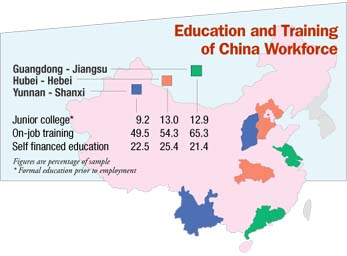|
.gif)
 |
The effect of education and training on employees
in three regions of China in contrasting stages of economic develop-ment
have been mapped by researchers at The Chinese University of Hong Kong.
 Principal
Investigator Dr Jin Xiao and colleagues in collaboration with the State
Centre of Research on Education Development, surveyed more than 30,000
employees in the fast-growing eastern regions of Jiangsu and Guangdong
(see Principal
Investigator Dr Jin Xiao and colleagues in collaboration with the State
Centre of Research on Education Development, surveyed more than 30,000
employees in the fast-growing eastern regions of Jiangsu and Guangdong
(see  areas
in map), the less prosperous central regions of Hubei and Hebei ( areas
in map), the less prosperous central regions of Hubei and Hebei ( ); and the comparatively underdeveloped western regions of Yunnan and
Shanxi (
); and the comparatively underdeveloped western regions of Yunnan and
Shanxi ( ). ).
 “The
transition from a planned to a market economy in the western provinces
lags behind Jiangsu and Guangdong by about 15 to 20 years,” said
Dr Xiao, “and it shows in our research findings.” “The
transition from a planned to a market economy in the western provinces
lags behind Jiangsu and Guangdong by about 15 to 20 years,” said
Dr Xiao, “and it shows in our research findings.”
 Among
results, she found that on-job training provided by companies in the more
prosperous areas was significantly higher than in the poorer regions.
She said: “Companies won autonomy under market economy reforms but
they also discovered a lot of pressure; they had to reform their management
ideas to survive. Among
results, she found that on-job training provided by companies in the more
prosperous areas was significantly higher than in the poorer regions.
She said: “Companies won autonomy under market economy reforms but
they also discovered a lot of pressure; they had to reform their management
ideas to survive.
 “Under
the planned economy, orders went from government to factories which produced
products and gave them back to the government. Now companies need employees
to promote their products and secure orders, so employees need new sets
of skills.” “Under
the planned economy, orders went from government to factories which produced
products and gave them back to the government. Now companies need employees
to promote their products and secure orders, so employees need new sets
of skills.”
 To
be profitable, companies also need to embrace new techniques like computer-aided
design and manufacturing. This means some old jobs have been replaced
by jobs requiring new skills, said Dr Xiao. To
be profitable, companies also need to embrace new techniques like computer-aided
design and manufacturing. This means some old jobs have been replaced
by jobs requiring new skills, said Dr Xiao.
 “The
level of on-job training reflects these new pressures,” she added.
Economic reforms came to Hubei and Hebei about nine years after Guangdong
but evidence that the gap is closing comes with the amount of formal education
received by workers prior to employment. In both regions, the number of
workers starting with a junior college education is now about the same
at 13 per cent. “The
level of on-job training reflects these new pressures,” she added.
Economic reforms came to Hubei and Hebei about nine years after Guangdong
but evidence that the gap is closing comes with the amount of formal education
received by workers prior to employment. In both regions, the number of
workers starting with a junior college education is now about the same
at 13 per cent.
 Individuals
can change job and location under the market economy, said Dr Xiao, so
they make good use of self-financed adult education as a way to get on.
She found that once a person is in a job, on-job training and self-financed
adult education have a much greater impact on salary growth than does
formal education. Individuals
can change job and location under the market economy, said Dr Xiao, so
they make good use of self-financed adult education as a way to get on.
She found that once a person is in a job, on-job training and self-financed
adult education have a much greater impact on salary growth than does
formal education.
Principal Investigator
Dr Jin Xiao : xiaojin@cuhk.edu.hk

|


![]()
